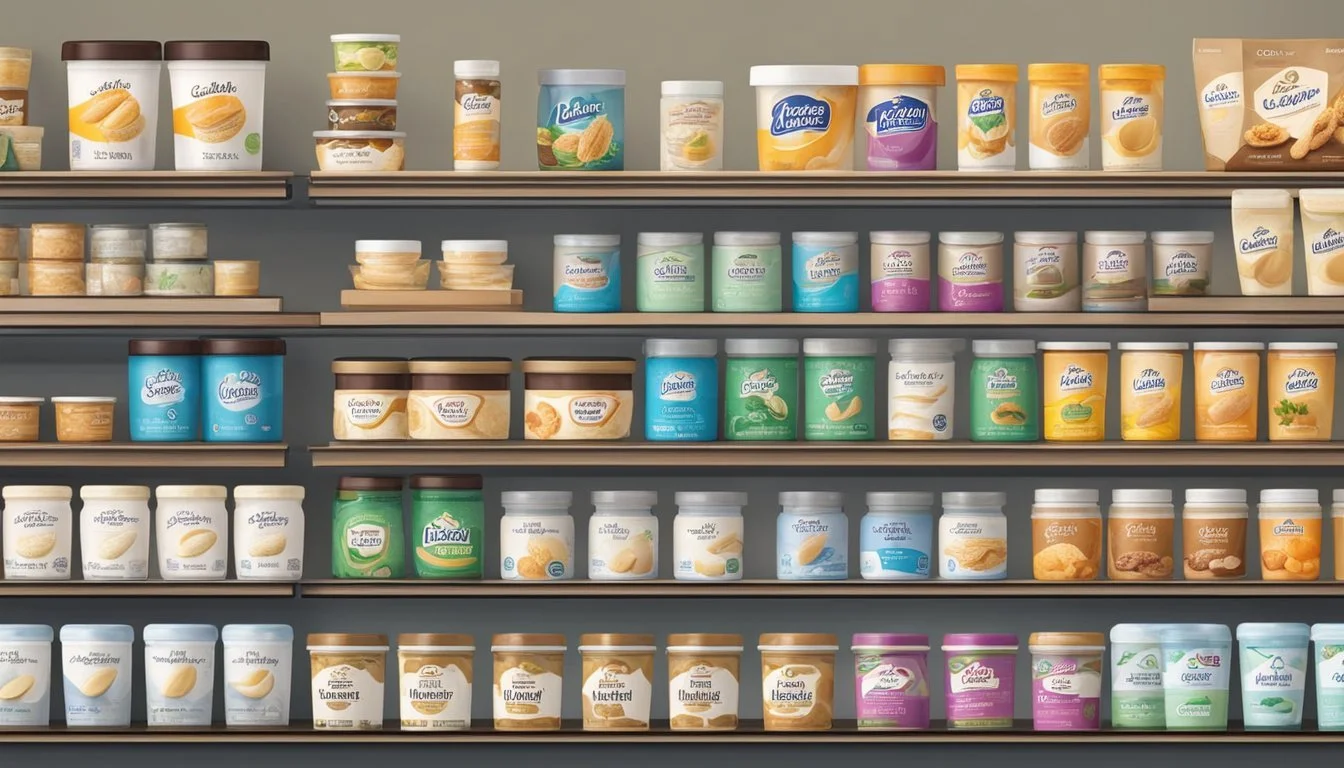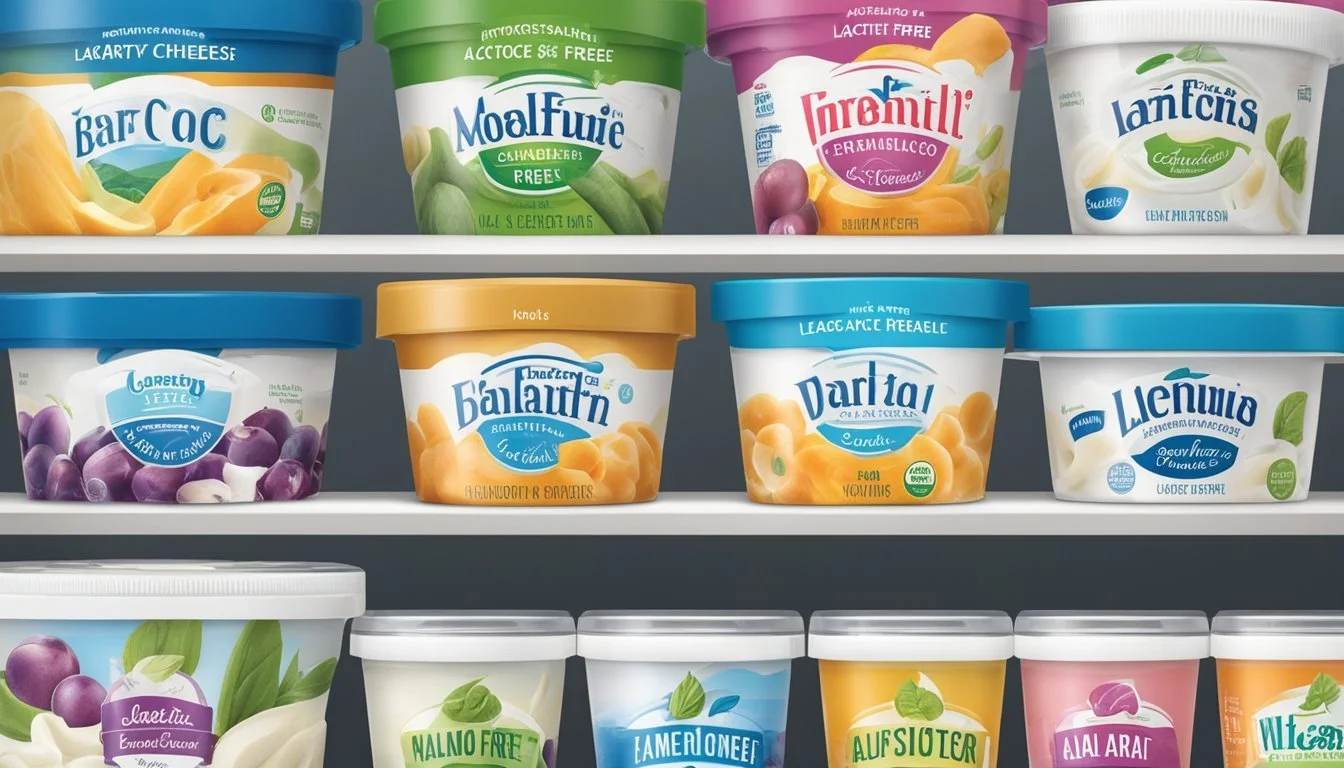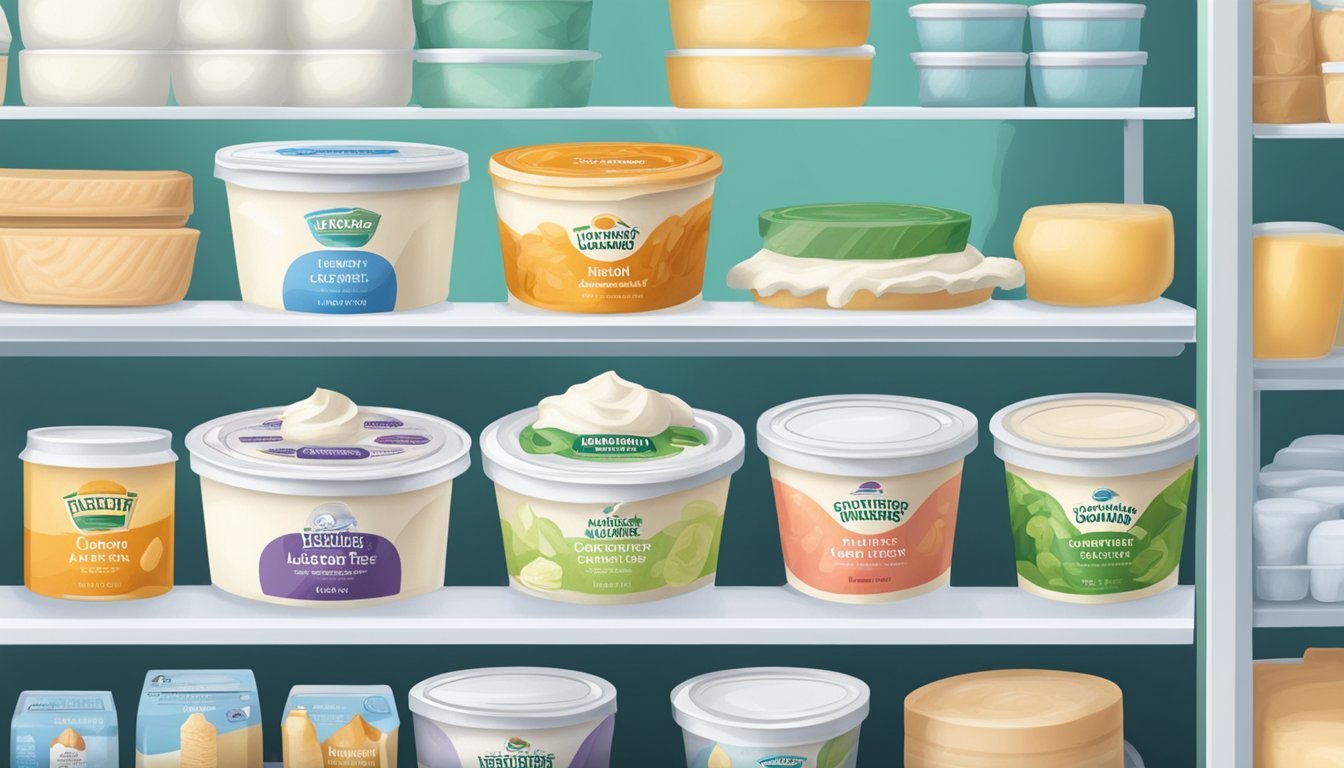What Are Some Lactose-Free Cream Cheese Options?
Your Guide to Dairy Alternatives
Individuals who are lactose intolerant, vegan, or have a dairy allergy often seek alternatives to traditional cream cheese. Lactose-free cream cheese is a product that caters to these dietary needs while aiming to replicate the taste and texture of regular cream cheese. Different brands offer lactose-free options that are crafted to ensure that those who avoid dairy due to an intolerance or allergy can still enjoy the rich, creamy experience of cream cheese. These alternatives are also suitable for those following a vegan diet, as they are free from animal products.
Market availability of lactose-free cream cheese has expanded, with numerous brands providing a variety of flavors and ingredients to cater to the growing demand. Some brands use plant-based ingredients such as coconut oil, pea protein, and various starches to mimic the consistency and flavor of traditional cream cheese. Others may produce cream cheese that is lactose-free but still contains dairy, using lactase enzyme to make it digestible for those with lactose intolerance. Each option offers a unique take on the classic spreadable cheese, with variations aimed at closely resembling the original dairy product in both taste and texture.
Dairy-free and vegan cream cheese alternatives, in particular, demonstrate the food industry's response to a diverse set of dietary preferences and requirements. These products are labeled accordingly to guide consumers who avoid dairy, whether it's due to health reasons or ethical choices. The selection process can be simplified with an understanding of the key ingredients and nutritional profiles, helping those on restricted diets to make informed choices without compromising on flavor.
Understanding Lactose Intolerance
Lactose intolerance occurs when an individual's body cannot effectively digest lactose, a sugar found in milk and dairy products. It typically arises from a deficiency of lactase, the enzyme responsible for breaking down lactose.
Lactose Intolerance Mechanism
Lactose intolerance stems from the inability of an individual's small intestine to produce an adequate amount of lactase enzyme. This enzyme is crucial as it breaks down lactose into glucose and galactose, which are easily absorbed into the bloodstream. When lactose is not properly digested, it moves into the large intestine where bacteria ferment it, often leading to the production of gas and other digestive discomforts.
Common Symptoms
The symptoms of lactose intolerance can range from mild to severe and usually manifest within a few hours following the consumption of lactose-containing foods. The most common symptoms include:
Bloating: A feeling of fullness or swelling in the abdominal area.
Gas: Increased production of gas can lead to discomfort and sometimes pain.
Nausea: A sensation of unease and discomfort in the stomach that might come with an urge to vomit.
Irregular lactose levels in various dairy products can affect the severity of these symptoms. For instance, the lactose content in cream cheese is lower than in milk, potentially leading to less pronounced symptoms for some individuals with lactose intolerance.
Benefits of Lactose-Free Cream Cheese
Lactose-free cream cheese offers several health benefits, particularly for those with lactose intolerance or dairy sensitivities. Besides being easier to digest, it can also offer nutritional advantages that cater to specific dietary needs.
Nutritional Advantages
Lactose-free cream cheese is often made from alternative bases such as coconut oil, soy, nuts, or root vegetables. These bases can increase the diversity of nutrients in a diet. For instance, cream cheese styles made from nuts like almonds can offer additional healthy fats and vitamins. They often come enriched with probiotic cultures, which can contribute to a healthy gut microbiome.
Additionally, lactose-free alternatives can be lower in cholesterol and saturated fat compared to traditional dairy-based cream cheeses. It's important to note that nutritional content can vary widely between brands and recipes, so consumers should check labels carefully.
Digestive Benefits
The primary enzyme responsible for the digestion of lactose is lactase. Individuals lacking this enzyme experience lactose intolerance, which can lead to uncomfortable digestive symptoms. Lactose-free cream cheeses contain either no lactose or enzymes that break down lactose, making them a digestible option for these individuals.
For those who are lactose intolerant, consuming lactose-free options means they can enjoy the creaminess of cream cheese without the associated gastrointestinal distress. The removal of lactose from these products can prevent symptoms such as bloating, gas, and cramping. Moreover, the various non-dairy bases used in lactose-free cream cheeses can also be beneficial for people with allergies or sensitivities to dairy proteins.
Types of Lactose-Free Cream Cheese
In the market for lactose-free cream cheese, consumers can find a variety of plant-based alternatives that cater to dietary restrictions without sacrificing flavor and texture. These products often utilize ingredients such as soy, coconut oil, cashews, almond milk, and pea protein to replicate the creamy consistency of traditional cream cheese.
Soy-Based Alternatives
Soy-based cream cheeses are a popular choice for those seeking a lactose-free option. They are made primarily from soy milk which is then fermented and thickened to mimic the classic cream cheese texture. Soy-based cream cheeses are known for their smooth consistency and are often fortified with live cultures to enhance their flavor profile.
Coconut Oil-Based Options
Lactose-free cream cheeses made with coconut oil are known for their rich and creamy texture. Coconut oil provides a buttery mouthfeel that resembles the indulgence of traditional creams. These varieties are often blended with other plant-based ingredients to achieve a balanced taste and are suitable for consumers who prefer a vegan lifestyle.
Almond and Cashew-Based Spreads
Almond and cashew-based cream cheeses utilize ground nuts to create a thick, spreadable consistency. These alternatives not only offer a rich texture but also contribute to a subtly sweet and nutty flavor, making them a favored choice among those who are lactose intolerant or follow a plant-based diet.
Pea Protein-Infused Varieties
Pea protein-infused cream cheeses are a newer addition to the lactose-free market. They harness the power of pea protein to provide a robust texture similar to that of dairy cream cheese. Pea protein varieties are often chosen for their high protein content and ability to maintain a creamy consistency without the use of dairy.
Popular Lactose-Free Brands
Consumers looking for lactose-free cream cheese options have several popular brands to choose from. These brands provide a variety of flavors and textures, catering to different dietary needs and taste preferences.
Tofutti
Tofutti offers a well-known product called Tofutti Better Than Cream Cheese, which is soy-based and available in several varieties. It's designed to mimic the taste and texture of traditional cream cheese for those avoiding lactose.
Daiya
Daiya is a leading brand in the vegan cheese market. Their cream cheese style spread is dairy-free, soy-free, and gluten-free, making it an inclusive option for individuals with various dietary restrictions.
Kite Hill
Kite Hill specializes in almond-based dairy alternatives, including soft fresh artisanal foods. Their almond milk-based cream cheese is known for its smooth texture and is suitable for a plant-based diet.
Follow Your Heart
Follow Your Heart provides a variety of vegan and lactose-free products, including a cream cheese alternative that aims to deliver the creamy and tangy flavor profile lactose-intolerant individuals often miss.
Miyoko’s Creamery
Miyoko’s Creamery creates products using organic ingredients when possible. Their vegan cream cheese is cashew-based and lauded for its rich, indulgent flavor.
Go Veggie
Go Veggie offers a line of lactose-free cheese products that include a cream cheese alternative. They strive to achieve great taste while being mindful of lactose-intolerant consumers' needs.
Violife
Violife produces a range of dairy-free cheese alternatives. Their cream cheese is coconut-based and free from soy and gluten, focusing on a creamy texture and taste that appeals to a broad audience.
Treeline
Treeline emphasizes artisanal methods in their plant-based cheese products. Their French-style soft cheese is made from cashew nuts and available in various flavors that offer a unique take on traditional cream cheese.
These brands have made significant strides in the development of lactose-free cream cheeses, focusing on quality and taste without compromising on dietary needs.
Homemade Lactose-Free Cream Cheese
Creating lactose-free cream cheese at home allows individuals to enjoy a delicious spread without the negative effects of lactose. It also lets them customize the flavor and texture to their liking, using simple, organic ingredients without unwanted additives.
Basic Ingredients for DIY
For those looking to make their own lactose-free cream cheese, the basic ingredients include:
Base: Coconut cream or cashew milk are popular dairy-free alternatives.
Acid: Lemon juice is typically used to provide the necessary acidity.
Thickener: Tapioca starch can help achieve the desired consistency.
Flavor Enhancers: Nutritional yeast, sea salt, garlic powder, and onion powder add depth of flavor.
Culturing Agent: Probiotics can be used to ferment the base and develop a cheese-like tang.
A typical recipe would involve blending these ingredients until smooth and then allowing the mixture to ferment to develop the flavors.
Recipe and Preparation
1. Culturing the Base:
Combine 2 cups of coconut cream or cashew milk with a culturing agent such as probiotic powder (1-2 capsules).
Add 1 tablespoon of lemon juice and 1/2 teaspoon of sea salt for flavor.
Mix in optional flavors, such as 1/2 teaspoon of garlic powder and 1/2 teaspoon of onion powder.
2. Thickening the Blend:
Stir in 2 tablespoons of tapioca starch to help thicken the mixture.
3. Fermentation:
Cover the mixture and let it sit in a warm place for 24-48 hours.
The mixture should slightly thicken and develop a tangy flavor.
4. Final Touches:
After fermentation, give the cream cheese a final stir.
If a smoother texture is desired, blend the mixture again until it reaches the preferred consistency.
Taste and adjust seasoning with additional nutritional yeast, lemon juice, or sea salt as needed.
For a more intense flavor, ingredients like chives or fresh herbs can be folded into the finished cream cheese. Using organic ingredients where possible ensures the cream cheese is free from unwanted pesticides and chemicals. Homemade lactose-free cream cheese can be refrigerated and used as a spread or in recipes just like traditional cream cheese.
Choosing the Right Lactose-Free Cream Cheese
When selecting a lactose-free cream cheese, consumers need to consider their dietary restrictions and understand the labeling to ensure the product meets their needs.
Considerations Based on Diet
Consumers should first identify whether lactose-free or dairy-free suits their dietary needs. Lactose-free cream cheeses are made from dairy but have the lactose removed, making them suitable for those with lactose intolerance. Conversely, dairy-free alternatives are entirely plant-based and appropriate for vegans or those with dairy allergies. Here are some specific examples:
Lactose-free options: These often contain milk where the lactose has been broken down and may include brands like Green Valley Creamery.
Dairy-free alternative: These substitutes usually derive from plant sources like almonds, soy, or coconut. Brands to look for include Daiya, Kite Hill, and Miyoko's Creamery, which often use cashews or almonds as a base.
Understanding Labels
Reading labels carefully is crucial for consumers with dietary restrictions. Lactose-free labels should indicate the absence of lactose, while vegan labels guarantee that the product contains no animal by-products, including dairy. Here's a quick reference for label comprehension:
Label Type Meaning Lactose-Free Contains dairy but no lactose. Dairy-Free No dairy ingredients, suitable for vegans. Plant-Based/ Vegan Made from plants, does not contain dairy or other animal products.
Labels may also provide information on milk substitutes used, such as almond, soy, or oat milk. This is especially useful for those who may have nut allergies or prefer certain types of milk substitutes. Additionally, some products may also include vegan butter in the ingredients, which is another aspect to be mindful of if one has specific dietary preferences or requirements.
Lactose-Free Cream Cheese in Recipes
In the culinary world, lactose-free cream cheese serves as a versatile ingredient that can seamlessly substitute traditional cream cheese in various recipes. Its application in cooking and baking demonstrates its convenience for those with dietary restrictions without compromising taste or texture.
Cooking and Baking Uses
Lactose-free cream cheese can be incorporated into baking recipes to create rich, moist textures. It is particularly useful in making cheesecakes, wherein it offers an alternative that is indistinguishable from its lactose-containing counterpart. Chefs may also use it in sauces to add a creamy and thick consistency to pasta dishes, while ensuring the dish remains lactose-free.
In baking, lactose-free cream cheese can be used to produce a wide array of culinary creations. From frosting for cakes and cupcakes to a filling for pastries, it behaves similarly to traditional cream cheese under heat. It's important to note that slight variations in moisture content may require adjustments to the original recipe.
Snacks and Spreads
Lactose-free cream cheese excels as a spread for bagels and crackers, offering the creamy texture and tangy flavor people expect from a classic spread. One can enjoy it plain or enhance it with herbs, fruits, or spices for a flavorful kick.
When considering snacks, lactose-free cream cheese can be used in pinwheels, stuffed celery, or as a base for dips. The absence of lactose allows people with lactose intolerance to enjoy these snacks without discomfort. This alternative not only caters to dietary needs but also maintains the integrity of the original dish, ensuring everyone can savor traditional flavors.
Storing Lactose-Free Cream Cheese
When it comes to storing lactose-free cream cheese, maintaining its freshness and preventing spoilage is key. Just like traditional cream cheese, the lactose-free variant requires refrigeration. Below are the best practices to ensure that your lactose-free cream cheese stays in optimum condition for as long as possible.
Unopened Packs:
Refrigeration: Store unopened lactose-free cream cheese in the refrigerator, at a temperature below 40°F (4°C).
Original Packaging: Keep it in its original packaging to prevent contamination and protect its flavor.
After Opening:
Airtight Containers: Transfer the opened lactose-free cream cheese to an airtight container if not stored in its original resealable packaging.
Prompt Return: After use, return the cream cheese to the refrigerator promptly to avoid prolonged exposure to room temperature.
Avoid Cross-Contamination:
Always use clean utensils when scooping out the cream cheese to prevent the introduction of bacteria.
Shelf Life:
Typical Duration: An opened package of lactose-free cream cheese generally stays fresh for up to two weeks when stored properly.
Expiration Date: Always check the expiration date and adhere to it, even if the cream cheese looks and smells fine.
Freezing:
While freezing is possible, it may alter the texture, making it crumbly and less spreadable. It is best used in cooked or baked recipes if frozen and thawed.
It is important to note that lactose-free does not mean the product is entirely dairy-free. Those with a dairy allergy should seek alternatives. Proper storage is essential for maintaining the integrity of lactose-free cream cheese and enjoying its intended flavor and texture.
Health Considerations and Alternatives
When considering lactose-free cream cheese options, it is important to address both potential allergens and sensitivities, as well as to explore the various non-dairy cheese alternatives available. The selections offered not only cater to those with lactose intolerance but also to individuals seeking plant-based options due to allergies, health preferences, or dietary restrictions.
Potential Allergens and Sensitivities
In the quest for lactose-free alternatives to cream cheese, consumers should be aware that products may contain other allergens. Although removing cow’s milk from the equation eliminates lactose, other ingredients can trigger sensitivities or allergic reactions. Here are some common allergens found in dairy-free cheese alternatives:
Soy: A prevalent ingredient in non-dairy substitutes, soy can cause allergies in some individuals.
Tree nuts: Almonds and cashews are often used in vegan cheeses, posing a risk for those with tree nut allergies.
Gluten: Some plant-based cheese products may contain gluten, necessitating careful label reading for individuals with gluten intolerance or celiac disease.
Non-Dairy Cheese Alternatives
A variety of plant-based milk products serve as the base for non-dairy cheese substitutes. Each offers its own nutritional profile and flavor nuances, making them suitable for different culinary uses. Below are the common bases for lactose-free cream cheeses and how they compare to traditional dairy products:
Soy Milk-Based: Soy milk provides a creamy texture similar to cream cheese and is a frequent choice for those converting to dairy-free products.
Coconut Milk-Based: Coconut milk offers a rich texture and a subtly sweet flavor, working well in spreads and frostings.
Almond Milk-Based: An almond base yields a spread with a nutty flavor and is typically lighter in texture compared to soy or coconut options.
Oat Milk-Based: Oat milk alternative is newer on the market, known for its mild flavor and is a good option for those with soy and nut allergies.
Plant-Based Blends: Some brands combine various plant milks to achieve a balance of flavor and consistency closer to dairy cream cheese.
By considering both health considerations and the available alternatives, consumers can make informed choices that accommodate their dietary needs while enjoying a variety of texture and flavor profiles.
Nutritional Comparison
When opting for lactose-free cream cheese, it is essential to consider the nutritional aspects in comparison to traditional dairy cream cheese. Factors such as calorie content, fat, sugar, and the presence of lactose are particularly noteworthy.
Lactose-Free vs Dairy Cream Cheese
Lactose-free cream cheese is designed to be similar in calorie content to its dairy counterpart. However, the key distinction lies in the absence of lactose, making it a suitable alternative for those with lactose intolerance or allergies. Brands may use a blend of non-dairy ingredients such as coconut oil, pea protein, or nuts, which can slightly alter the nutritional profile.
Traditional Dairy Cream Cheese
Calories: Approximately 100 calories per 1-ounce serving
Lactose: Typically 2-3%
Lactose-Free Cream Cheese
Calories: Comparable to dairy cream cheese
Lactose: 0%
Fat and Sugar Content
The fat content in lactose-free cream cheeses can vary depending on the base ingredients used. Some brands may use oils that contain higher saturated fats, while others might incorporate healthier fat alternatives. It is noteworthy that the sugar content in both lactose-free and dairy cream cheeses is generally low, as they are not inherently sweet products.
Dairy Cream Cheese
Fat: Varies around 9 grams per 1-ounce serving (saturated fat content can be around 5 grams)
Sugar: Generally less than 1 gram
Lactose-Free Cream Cheese
Fat: Can range similarly to dairy cream cheese, though the source of fats differs
Sugar: Minimal, similar to dairy cream cheese
Conclusion
For individuals seeking lactose-free alternatives to cream cheese, the market provides several satisfying substitutes. Dairy-free cream cheese options are often crafted from plant-based ingredients such as coconut cream, almonds, and soy. Tofu, particularly silken or soft pureed tofu, presents a versatile base for a dairy-free spread, appreciated for its smooth texture and mild flavor.
These alternatives not only cater to those with lactose intolerance but also to anyone following a vegan diet or looking to reduce dairy intake. Brands like Kite Hill offer products that closely mimic the taste and texture of traditional cream cheese, making them a popular choice among both dairy consumers and dairy avoiders.
Taste: Plant-based cream cheeses can be enriched with ingredients such as lemon juice, nutritional yeast, or salt to enhance their flavor profile.
Uses: They perform well in various culinary applications, including spreads, creamy sauces, dips, and desserts.
It is important to check the labels for nutritional content and to ensure that the product meets specific dietary needs. As the demand for plant-based products continues to grow, consumers can expect to see innovation and expansion in the market of dairy-free cream cheese alternatives.








